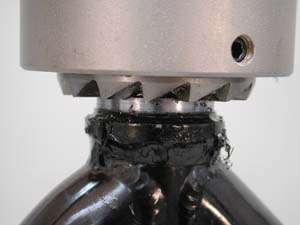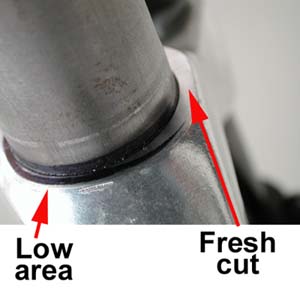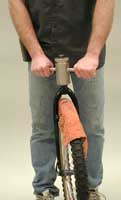Fork Crown Race Cutting and Facing
This article will review the use of the Crown Race Cutter to machine and face the fork race seat.
Press Fit
- Repair Stand, holds bike secure for easy work.
- Crown Race Cutter: CRC-1
- Measuring Caliper: DC-2
- Cutting Fluid: CF-2
- Degreaser: CB-4
- Rags
The fork crown race is seated onto the fork crown. Generally this is press fit, with the inside diameter of the crown race being smaller than the fork crown. To determine the fit, measure both the inside diameter of the fork crown race and the outside diameter of the fork crown. A difference between 0.05mm to 0.15mm is generally considered acceptable. Differences less than 0.05mm may be a weak fit and may come loose during use. A strong bearing compound is recommend in weak fits. Differences greater that 0.15mm may damage the fork crown race as it is press onto the fork crown. The fork crown may be machined for correct size with the CRC-1.

The cutting process can take a long time if the crown race must be resized. As an example, when reducing the JIS standard of 27.1mm fork crown size down to 26.4mm crown race size it is necessary to remove 0.7mm material. The cutter of the CRC-1 uses the inside edge to machine the correct diameter as it passes down the steering column.
Facing
In addition to a correct press fit, the flat seat of the crown race must be square to the steering column. The headset fork crown race will be pressed on the crown race and will reference the seat for bearing alignment. Without correct bearing alignment, the headset bearings may bind as it is rotated side to side.
The paint on the fork may be used as a marker to track facing. A fresh cut should be seen completely around the crown. Additionally, the cut should be as wide as practical. Fork crown races tend to seat on their outer edge. This crown below shows incomplete facing. Black mark shows a low area, which would cause bearing to seat misaligned relative to the steering column.

The Park Tool CRC-1 Crown Race Cutter will both size the crown race and machine the crown race seat. The CRC-1 comes with two cutters. One cutter is double sided, with 26.5mm and 27.1mm for one-inch forks. The CRC-1 also includes a 30.1mm cutter for 1-1/8-inch forks. The CRC-1 uses centering collets to help guide the cutter accurately over the crown race. These collets can be adjusted while the tool is on the fork.
It is necessary to hold the fork while cutting the crown. It is possible to use wood over the jaws of a vise while holding the fork. Alternatively, clamp a front wheel in the fork and stand over the fork while cutting. Protect the tire while cutting with a rag.

CRC-1 Procedures
- Determine the correct cutter and install cutter. If in doubt about the size, use a caliper and measure the inside diameter.
- Install the correct size collet. One-inch forks use the black collet. 1-1/8 inch forks use the blue collet. Leave adjustment collet cap loose.
- Tighten collet cap to remove play from the CRC-1 body.
- Lubricate cutting area with CF-1.
- Turn CRC-1 CLOCKWISE only. Apply downward pressure while turning.
- Continue to turn until the CRC-1 contacts the crown race seat. Turn 2–3 turns at this point.
- Loosen collet cap and pull tool upward to check progress. The crown race seat needs to have a fresh cut completely around the fork.
- Clean fork and clean cutting tool. NOTE: Never use compressed air to clean metal chips.
NOTE: All cutting tools will eventually require resharpening. With use, the cutting edge will dull. While there are many variables that play a role in how long a cutting tool will stay sharp (e.g. technique used, amount and type of lubrication used, type of material being machined, etc.), in general, have the tool resharpened once a year. For sharpening services of cutting tools see Park Tool Sharpening Services. Always use cutting fluid such as Park Tool CF-2 when machining.